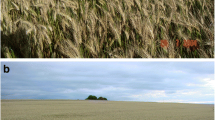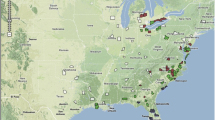Abstract
The weather-based forecasting model ZWIPERO was developed by the German Weather Service and determines the risk of sporulation and infection of Peronospora destructor quantitatively based on actual as well as predicted weather data (temperature, relative humidity, leaf wetness, precipitation). The model allows precise planning of disease monitoring and infection-related application of fungicides. ZWIPERO is a more complex mathematical model than the previously published models for downy mildew. In order to operate ZWIPERO independently of the actual field location and season, the time of sunrise and sunset of the location are exactly determined by a subroutine. Another subroutine provides simulated microclimatic input variables based on local production data as well as actual and hourly predicted (up to 4 days) standard weather data. Starting at the time of 'sunrise + 7 h', ZWIPERO calculates the number of sporangia produced, the time of onset of sporangia release, as well as the number of infections possible and the number of sporangia which may survive the day for each 24-h time step. Field evaluations of sporulation periods of downy mildew showed that the simulated micrometeorological input variables are reliable. As the actual plant development, the susceptibility and the disease incidence in the field are not taken into account, ZWIPERO has to be considered primarily as a decision support system for extension services and growers.
Similar content being viewed by others
References
Analytis S (1977) Ñber die Relation zwischen biologischer Entwicklung und Temperatur bei phytopathogenen Pilzen. Phytopathologische Zeitschrift 90: 64-76
Anderson DB (1936) Relative humidity or vapor pressure deficit. Ecology 17: 277-282
Bashi E and Aylor DE (1983) Survival of detached sporangia of Peronospora destructor and Peronospora tabacina. Phytopathology 73: 1135-1139
Battilani P, Rossi V, Racca P and Giosuè S (1996) ONIMIL, a forecaster for primary infection of downy mildew of onion. Bulletin OEPP/EPPO 26: 567-576
Berry SZ (1959) Resistance of onion to downy mildew. Phytopathology 49: 486-496
Braden H (1995) The model AMBETI. A detailed description of a soil-plant-atmosphere model. Berichte des Deutschen Wetterdienstes, Offenbach/M. Nr. 195
Cook HT (1932) Studies on the downy mildew of onions, and the causal organism, Peronospora destructor (Berk.) Caspary. New York, Agricultural Experiment Station, Ithaca (Mem. 143)
Delp CJ (1954) Effect of temperature and humidity on the grape powdery mildew fungus. Phytopathology 44: 615-626
de Visser CLM (1998) Development of a downy mildew advisory model based on downcast. European Journal of Plant Pathology 104: 933-943
de Weille GA (1975) An approach to the possibilities of forecasting downy mildew infection in onion crops. Koninklijk Nederlands Meteorologisch Instituut, Mededelingen en Verhandelingen No. 97
Friedrich S (1994) Prognose der Infektionswahrscheinlichkeit durch Echten Mehltau an Winterweizen (Erysiphe graminis DC. f. sp. tritici) anhand meteorologischer Eingangsparameter. Ph.D. Thesis, Technical University Braunschweig, Germany. Verlag Mainz, Aachen, Germany
Friedrich S and Boyle C (1997) Simulation of infection probability of powdery mildew in winter wheat. In: Munack A and Tantau HJ (eds) Mathematical and Control Applications in Agriculture and Horticulture (pp 243-248) Pergamon Press, Oxford, England
Hartmann H, Sutton JC and Procter R (1983) Effects of atmospheric water potentials, free water, and temperature on production and germination of sporangia in Peronospora parasitica. Canadian Journal of Plant Pathology 5: 70-74
Hildebrand PD (1983) Effects of environmental variables on the infection cycle and epidemiology of Peronospora destructor (Berk.) Casp. in onion. Ph.D. Thesis, University of Guelph, Canada
Hildebrand PD and Sutton JC (1982) Weather variables in relation to an epidemic of onion downy mildew. Phytopathology 72: 219-224
Hildebrand PD and Sutton JC (1984a) Interactive effects of the dark period, humid period, temperature, and light on sporulation of Peronospora destructor. Phytopathology 74: 1444-1449
Hildebrand PD and Sutton JC (1984b) Effects of weather variables on spore survival and infection of onion leaves by Peronospora destructor. Canadian Journal of Plant Pathology 6: 119-126
Hildebrand PD and Sutton JC (1984c) Relationships of temperature, moisture, and inoculum density to the infection cycle of Peronospora destructor. Canadian Journal of Plant Pathology 6: 127-134
Jesperson GD and Sutton JC (1987) Evaluation of a forecaster for downy mildew of onion (Allium cepa L.). Crop Protection 6: 95-103
Johnson DA and Shaw CG (1985) Downy mildew of onion. Washington State University, Pullman Washington, Extension Bulletin 1310
Leach CM, Hildebrand PD and Sutton JC (1982) Sporangium discharge by Peronospora destructor: Influence of humidity, red-infrared radiation, and vibration. Phytopathology 72: 1052-1056
Löpmeier FJ and Friesland H (1998) The German agrometeorological forecast system 'AMBER'. In: Dalezios NR (ed) International Symposium on Applied Agrometeorology and Agroclimatology. COST 77,79,711 (pp 371-376) Office for Official Publications of the European Communities, Luxembourg
O'Brien RG (1992) Control of onion downy mildew in the presence of phenylamide-resistant strains of Peronospora destructor (Berk.) Caspary. Australian Journal of Experimental Agriculture 32: 669-674
Palti J (1989) Epidemiology, prediction and control of onion downy mildew caused by Peronospora destructor. Phytoparasitica 17: 31-48
Stevens NE (1916) A method for studying the humidity relations of fungi in culture. Phytopathology 6: 428-432
Schwartz HF and Mohan SK (eds) (1995) Compendium of Onion and Garlic Diseases. APS Press, St. Paul, MN, USA
Strathmann S (1984) Zum Sporenflug getreidepathogener Pilze-Befallsentwicklung und Ertragsgestaltung in Sortenmischungen des Weizens. Ph.D. Thesis, University of Goettingen, Germany
Sutton JC and Hildebrand PD (1985) Environmentalwater in relation toPeronospora destructor and related pathogens. Canadian Journal of Plant Pathology 7: 323-330
Tuzun S, Juarez J, Nesmith, WC and Kuc J (1992) Induction of systemic resistance in tobacco against metalaxyl-tolerant strain of Peronospora tabacina and the natural occurrence of the phenomenon in Mexico. Phytopathology 82: 425-429
van Doorn AM (1959) Investigations on the occurrence and the control of downy mildew (Peronospora destructor) in onions. Tijdschrift voor Plantenziekten 65: 193-255
Virànyi F (1974) Studies on the biology and ecology of onion downy mildew (Peronospora destructor (Berk.) Fries) in Hungary. II. Factors influencing sporulation and conidium germination. Acta Phytopathologica Academiae Scientiarum Hungaricae 9: 315-318
Virànyi F (1981) Downy mildew of onion. In: Spencer DM (ed) The Downy Mildews (pp 461-472) Academic Press, London
Vishunavat K, Nashaat NI, Heran A and Kolte SJ (1998) Sensitivity to the racemic mixture and isomeric forms of metalaxyl in Indian and European homothallic and heterothallic isolates of Peronospora parasitica in Brassica species. Crop Protection 17: 543-546
Wiglesworth MD, Reuveni M, Nesmith WC, Siegel MR, Kuc J, Juarez J (1988) Resistance of Peronospora tabacina to metalaxyl in Texas, USA, and Mexico. Plant Disease 72: 964-967
Yarwood CE(1943) Onion downy mildew. Hilgardia 14: 595-691
Author information
Authors and Affiliations
Corresponding author
Rights and permissions
About this article
Cite this article
Friedrich, S., Leinhos, G. & Löpmeier, FJ. Development of ZWIPERO, A Model Forecasting Sporulation and Infection Periods of Onion Downy Mildew based on Meteorological Data. European Journal of Plant Pathology 109, 35–45 (2003). https://doi.org/10.1023/A:1022024612563
Issue Date:
DOI: https://doi.org/10.1023/A:1022024612563




